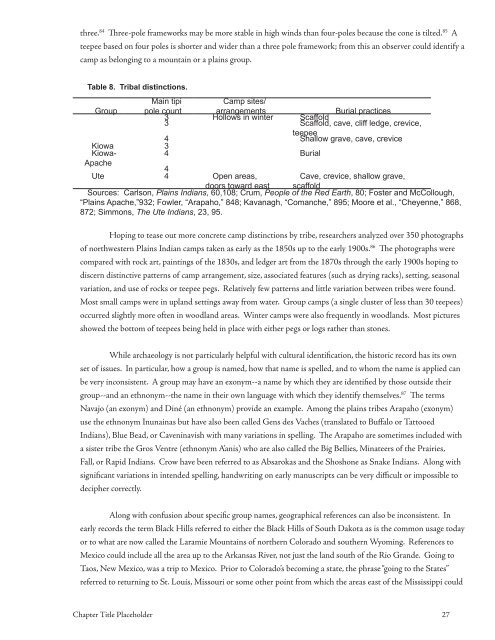People of the Poudre - Cache la Poudre National Heritage Area
People of the Poudre - Cache la Poudre National Heritage Area
People of the Poudre - Cache la Poudre National Heritage Area
Create successful ePaper yourself
Turn your PDF publications into a flip-book with our unique Google optimized e-Paper software.
three. 84 Three-pole frameworks may be more stable in high winds than four-poles because <strong>the</strong> cone is tilted. 85 Ateepee based on four poles is shorter and wider than a three pole framework; from this an observer could identify acamp as belonging to a mountain or a p<strong>la</strong>ins group.Table 8. Tribal distinctions.Main tipiCamp sites/Group pole count arrangementsBurial practicesHollows in winter Scaffold3 Scaffold, cave, cliff ledge, crevice,teepee4 Shallow grave, cave, creviceKiowa 3Kiowa-4 BurialApache4Ute 4 Open areas,doors toward eastCave, crevice, shallow grave,scaffoldSources: Carlson, P<strong>la</strong>ins Indians, 60,108; Crum, <strong>People</strong> <strong>of</strong> <strong>the</strong> Red Earth, 80; Foster and McCollough,“P<strong>la</strong>ins Apache,”932; Fowler, “Arapaho,” 848; Kavanagh, “Comanche,” 895; Moore et al., “Cheyenne,” 868,872; Simmons, The Ute Indians, 23, 95.Hoping to tease out more concrete camp distinctions by tribe, researchers analyzed over 350 photographs<strong>of</strong> northwestern P<strong>la</strong>ins Indian camps taken as early as <strong>the</strong> 1850s up to <strong>the</strong> early 1900s. 86 The photographs werecompared with rock art, paintings <strong>of</strong> <strong>the</strong> 1830s, and ledger art from <strong>the</strong> 1870s through <strong>the</strong> early 1900s hoping todiscern distinctive patterns <strong>of</strong> camp arrangement, size, associated features (such as drying racks), setting, seasonalvariation, and use <strong>of</strong> rocks or teepee pegs. Re<strong>la</strong>tively few patterns and little variation between tribes were found.Most small camps were in up<strong>la</strong>nd settings away from water. Group camps (a single cluster <strong>of</strong> less than 30 teepees)occurred slightly more <strong>of</strong>ten in wood<strong>la</strong>nd areas. Winter camps were also frequently in wood<strong>la</strong>nds. Most picturesshowed <strong>the</strong> bottom <strong>of</strong> teepees being held in p<strong>la</strong>ce with ei<strong>the</strong>r pegs or logs ra<strong>the</strong>r than stones.While archaeology is not particu<strong>la</strong>rly helpful with cultural identification, <strong>the</strong> historic record has its ownset <strong>of</strong> issues. In particu<strong>la</strong>r, how a group is named, how that name is spelled, and to whom <strong>the</strong> name is applied canbe very inconsistent. A group may have an exonym--a name by which <strong>the</strong>y are identified by those outside <strong>the</strong>irgroup--and an ethnonym--<strong>the</strong> name in <strong>the</strong>ir own <strong>la</strong>nguage with which <strong>the</strong>y identify <strong>the</strong>mselves. 87 The termsNavajo (an exonym) and Diné (an ethnonym) provide an example. Among <strong>the</strong> p<strong>la</strong>ins tribes Arapaho (exonym)use <strong>the</strong> ethnonym Inunainas but have also been called Gens des Vaches (trans<strong>la</strong>ted to Buffalo or TattooedIndians), Blue Bead, or Caveninavish with many variations in spelling. The Arapaho are sometimes included witha sister tribe <strong>the</strong> Gros Ventre (ethnonym A’anis) who are also called <strong>the</strong> Big Bellies, Minateers <strong>of</strong> <strong>the</strong> Prairies,Fall, or Rapid Indians. Crow have been referred to as Absarokas and <strong>the</strong> Shoshone as Snake Indians. Along withsignificant variations in intended spelling, handwriting on early manuscripts can be very difficult or impossible todecipher correctly.Along with confusion about specific group names, geographical references can also be inconsistent. Inearly records <strong>the</strong> term B<strong>la</strong>ck Hills referred to ei<strong>the</strong>r <strong>the</strong> B<strong>la</strong>ck Hills <strong>of</strong> South Dakota as is <strong>the</strong> common usage todayor to what are now called <strong>the</strong> Laramie Mountains <strong>of</strong> nor<strong>the</strong>rn Colorado and sou<strong>the</strong>rn Wyoming. References toMexico could include all <strong>the</strong> area up to <strong>the</strong> Arkansas River, not just <strong>the</strong> <strong>la</strong>nd south <strong>of</strong> <strong>the</strong> Rio Grande. Going toTaos, New Mexico, was a trip to Mexico. Prior to Colorado’s becoming a state, <strong>the</strong> phrase “going to <strong>the</strong> States”referred to returning to St. Louis, Missouri or some o<strong>the</strong>r point from which <strong>the</strong> areas east <strong>of</strong> <strong>the</strong> Mississippi couldChapter Title P<strong>la</strong>ceholder7


